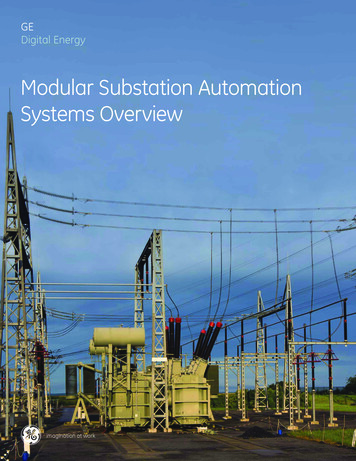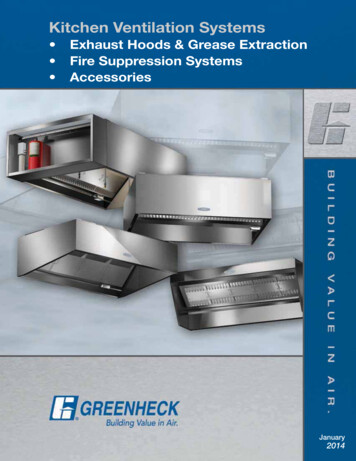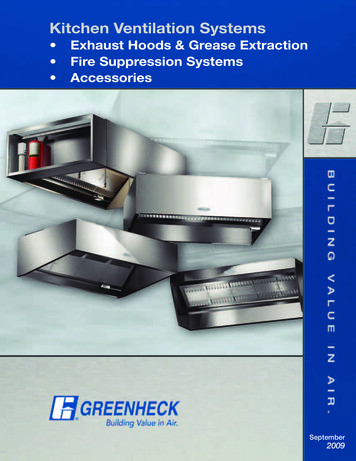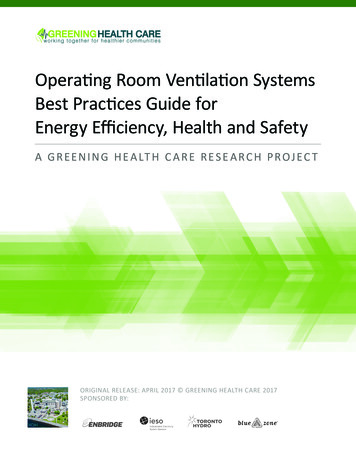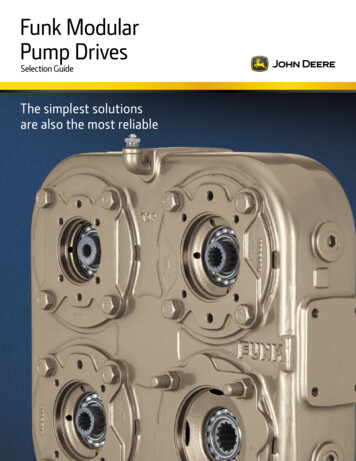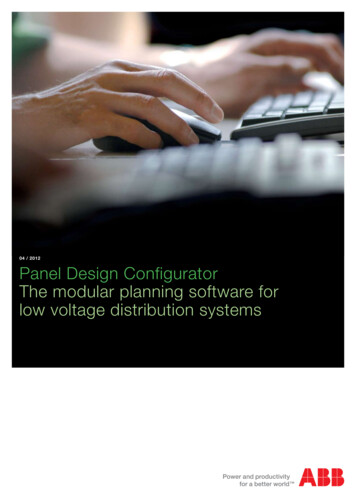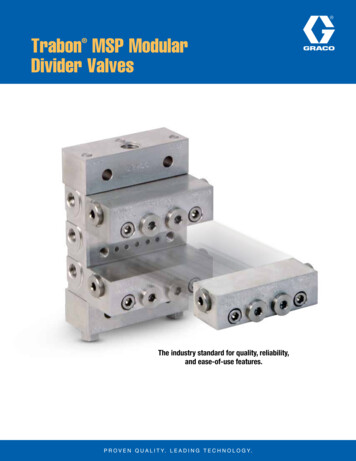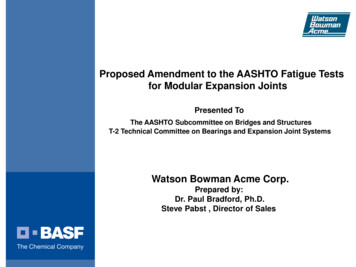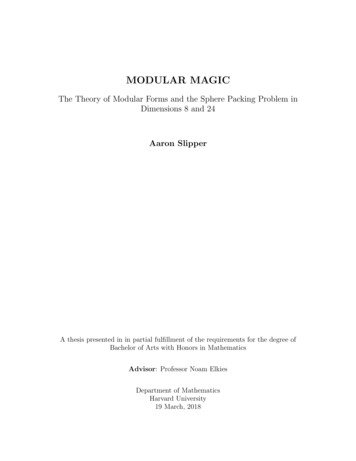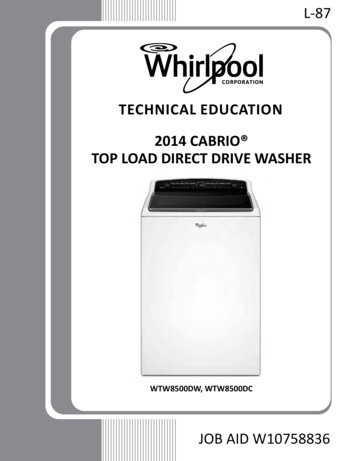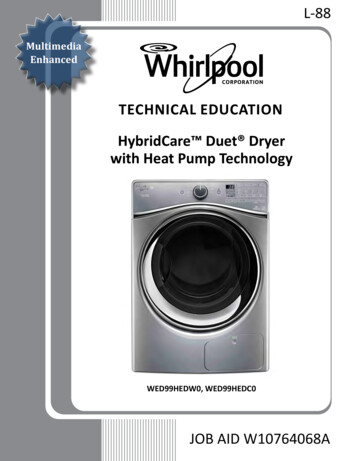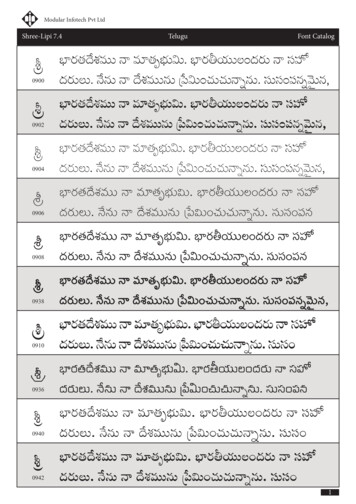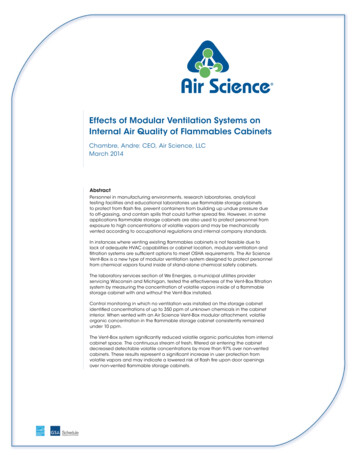
Transcription
Effects of Modular Ventilation Systems onInternal Air Quality of Flammables CabinetsChambre, Andre: CEO, Air Science, LLCMarch 2014AbstractPersonnel in manufacturing environments, research laboratories, analyticaltesting facilities and educational laboratories use flammable storage cabinetsto protect from flash fire, prevent containers from building up undue pressure dueto off-gassing, and contain spills that could further spread fire. However, in someapplications flammable storage cabinets are also used to protect personnel fromexposure to high concentrations of volatile vapors and may be mechanicallyvented according to occupational regulations and internal company standards.In instances where venting existing flammables cabinets is not feasible due tolack of adequate HVAC capabilities or cabinet location, modular ventilation andfiltration systems are sufficient options to meet OSHA requirements. The Air ScienceVent-Box is a new type of modular ventilation system designed to protect personnelfrom chemical vapors found inside of stand-alone chemical safety cabinets.The laboratory services section of We Energies, a municipal utilities providerservicing Wisconsin and Michigan, tested the effectiveness of the Vent-Box filtrationsystem by measuring the concentration of volatile vapors inside of a flammablestorage cabinet with and without the Vent-Box installed.Control monitoring in which no ventilation was installed on the storage cabinetidentified concentrations of up to 350 ppm of unknown chemicals in the cabinetinterior. When vented with an Air Science Vent-Box modular attachment, volatileorganic concentration in the flammable storage cabinet consistently remainedunder 10 ppm.The Vent-Box system significantly reduced volatile organic particulates from internalcabinet space. The continuous stream of fresh, filtered air entering the cabinetdecreased detectable volatile concentrations by more than 97% over non-ventedcabinets. These results represent a significant increase in user protection fromvolatile vapors and may indicate a lowered risk of flash fire upon door openingsover non-vented flammable storage cabinets.
p:2Andre Chambre, CEO, Air Science, LLC.March, 2014BackgroundRegulatory RequirementsFlammable liquid storage cabinets are used in a variety ofapplications to effectively separate substances with volatilevapors, from sources of ignition. Personnel in manufacturingenvironments, research laboratories, analytical testing facilitiesand educational laboratories use flammable storage cabinetsto protect from flash fire, prevent containers from building upundue pressure due to off-gassing, and contain spills thatcould further spread fire.1Flammable storage cabinets are designed as sealed systemswith no direct venting to the outside. This prevents ventilationserving as a potential point of entry for ignition sources andensures a completely closed system. However, risk of potentiallydangerous concentrations of volatile gases does exist and hasled to regulations on ventilation use on flammables cabinetsbased on application.The Occupational Safety and Health Administration (OSHA)regulations consider ventilation as it pertains to volatile, flammable liquids to be largely for the prevention of fire and explosion.Ventilation is adequate if it is sufficient to prevent accumulationof significant quantities of vapor-air mixtures in concentrationover one-fourth of the lower flammable limit, or the minimumproportion of vapor in air in which flame propagation can occur.2However, in some applications flammable storage cabinets arealso used to protect personnel from exposure to high concentrations of volatile vapors. In these instances, flammable storagecabinets may be mechanically vented according to occupational regulations and internal company standards.The primary basis of regulation for flammable and combustibleliquids is OSHA’s 29 CFR 1910.106 standard. This standard isderived from the National Fire Protection Association’s publicationNFPA 30, Flammable and Combustible Liquids Code and appliesto the handling, storage, and use of flammable and combustibleliquids with a flash point below 200ºF.Depending on a variety of factors, including industry, processand the requirements of individual corporate insurance carriers,flammables cabinets may be required to be vented in someindustrial and academic applications. OSHA requires thatemployers store flammable and potentially volatile chemicalsin properly rated flammables cabinets to protect against firehazards. Flammable storage cabinets are typically doublewalled and made out of 18-guage or thicker steel, with a doorsecured by a three-point lock system. Flammable storagecabinets must maintain internal temperatures of less than 325ºFduring a 10-minute fire test to meet OSHA regulations.In some instances, OSHA also recommends venting of flammables cabinets to prevent the buildup of chemical vapors whichcould be potentially hazardous to employees if exposed whileaccessing the cabinet. In these instances, venting is addressedthrough removal of specially designed bungs that allow connection of ventilation hoses to tie into an existing HVAC system.31 W.W. Grainger, Inc., “Flammables and Liquids, 29 CFR1910.106”. Quicktips: Technical Resources – Safety. 2:2013.2 United States Office of the Federal Register National Archivesand Records Administration, “29 Code of Federal RegulationsParts 1900 to 1910,” Washington: GPO 1994.Air Science3 Occupational Safety & Health Administration. “Flammableand Combustible Liquids, 29 CFR 1910.106”. OSHA TrainingMaterials.120 6th Street Fort Myers, FL 33907 T/239.489.0024 Toll Free/800.306.0656 F/800.306.0677 www.airscience.com
Effects of Modular Ventilation Systems on Internal Air Quality of Flammables Cabinetsp:3Issues with VentingModular Ventilation SystemsVenting flammables cabinets can be cost and logistics prohibitive, depending on the existing setup of the flammables cabinetswithin the facility. The National Fire Protection Association requiresflame arrestor screens and metal ducting be used when tyinga flammables cabinet into an existing HVAC system. To complywith the regulations, runs of ductwork must not exceed 25 feetand cannot be set up in a manifold system with other cabinets.The cabinets have to be vented from the top to the bottom andcannot be directly ducted to a fume hood. No spark fans andmotors are preferred when using mechanical ventilation systemsto mitigate risk of ignition sources.4In instances where venting existing flammables cabinets is notfeasible due to lack of adequate HVAC capabilities or cabinetlocation, modular ventilation and filtration systems are sufficientoptions to meet OSHA requirements.Figure 1: Compliant Ventilation SystemDUCTWORK 25’The Air Science Vent-Box is a new type of modular ventilation system designed to protect personnel from chemical vapors foundinside of stand-alone chemical safety cabinets. These ductless filtration systems are designed to protect laboratory personnel fromchemical vapors found inside of stand-alone chemical safetycabinets and serve as modular ventilation and filtration that fitsall chemical safety cabinets. The modular systems connect to thecabinet via a metal hose or ductwork to the flame arrestor on oneside of the cabinet while the other flame arrestor is open (bung, ifinstalled, should be removed).Lab HVAC SystemThe Vent-Box incorporates the Air Science Multiplex FiltrationSystem, a unique configuration that includes a pre-filter and mainfilter to create a chemical, physical or combination architectureto adsorb, neutralize or trap the target chemicals or particulateswhile constant negative pressure removes vapors and particulates from the cabinet’s interior.5Figure 3: Vent-Box SystemFigure 2: Non-Compliant Manifold SystemLab HVAC SystemDUCTWORK 25’The Vent-Box draws contaminated air from the cabinetinterior and filters it through the Multiplex Filtration system.In many cases, existing laboratory HVAC systems are notdesigned to incorporate flammable storage cabinets and mustbe retrofitted to incorporate additional ductwork for this purpose.More ductwork and additional vented cabinet space mayrequire the entire ventilation system to be recalibrated in order tomeet required standards.4 National Fire Protection Association, Flammable andCombustible Liquids Code Handbook. Sixth edition, ed.Robert Benedetti, 1996.5 www.airscience.com/21
Mechanical, modular cabinet ventilation systems can drasticallyreduce volatile vapor concentration from liquid off-gassing withinproperly maintained flammables cabinets. Modular, ductlessflammables ventilation systems developed by Air Science canoffer additional benefits that include short runs of ventilationducting, individualized exhaust options for easy configuration,and easy accommodation of “no manifold” policies.MethodsThe effectiveness of the Vent-Box filtration system was evaluatedby measuring the concentration of volatile vapors inside of aflammable storage cabinet in use by the laboratory servicessection of We Energies, an electric utilities provider servicingWisconsin and Michigan’s Upper Peninsula.6 The cabinet contained a variety of solvents typical of testing facilities in a numberof industries, including acetone, isopropyl alcohol, hexanes,decane, petroleum, fuel, lubricating oils, as well as unknownsamples awaiting testing.Vapor concentration inside the cabinet was measured with a3M Quest EVM-7 indoor air quality monitor. The 3M Quest EVM-7measured volatile organic vapor concentration in the air viaphoto-ionization detection (calibrated with 100 ppm isobutylene).7Internal air samples were taken every minute, on the minute for aperiod of six days in early 2013 with no ventilation system installed.The process was repeated 10 months later with an Air ScienceVent-Box filtration system installed on the storage cabinet.Figure 4: Internal air quality of flammables cabinetwith no ventilation installedGraph 1: 2-19-13 to 2-20-13350Concentration (PPM)HypothesisMarch, 2014300250200150DOOR OPEN 15 SEC100500DOOR OPENDOOR OPEN024681012Time (hours)14161820221416182022Graph 2: 2-20-13 to 2-21-13300Concentration (PPM)Andre Chambre, CEO, Air Science, LLC.p:4250200150DOOR OPEN 1 MIN100DOOR OPEN 30 SEC500Data on concentration of volatiles over time was compiled intoline graphs and results analyzed through visual comparison.DOOR OPEN3 MIN024681012Time (hours)Graph 3: 2-21-13 to 2-22-13Control monitoring identified concentrations of up to 350 ppmof unknown chemicals in the unvented cabinet. The only majordeviations to these levels were the result of door openings, whichallowed an infusion of air into the cabinet and consequentdilution of volatile vapors.Concentration (PPM)300Results250200150100DOOR OPEN 30 SEC500DOOR OPEN 6 MIN0246810121416182022Time (hours)Graph 4: 2-22-13 to 2-25-13Concentration (PPM)300250150100DOOR OPEN 1 MIN5006 www.we-energies.comDOOR OPEN 20 SEC200DOOR OPEN2 MIN AND 1 MINDOOR OPEN 1 MIN061218243036Time (hours)42487 www.3M.co.uk/ohesAir Science120 6th Street Fort Myers, FL 33907 T/239.489.0024 Toll Free/800.306.0656 F/800.306.0677 www.airscience.com546066
Effects of Modular Ventilation Systems on Internal Air Quality of Flammables Cabinetsp:5DiscussionWhen vented with an Air Science Vent-Box modular attachment,volatile organic concentration in the flammable storage cabinetconsistently remained under 10 ppm. The only variation to thisdata resulted from human intervention in the early morning oftwo of the monitoring sessions (noted below).The tested modular ventilation and filtration system significantly reduced volatile organic particulates from internal cabinet space. The continuous stream of fresh, filtered air enteringthe cabinet decreased detectable volatile concentrationsby more than 97% over non-vented cabinets. These resultsrepresent a significant increase in user protection from volatilevapors and may indicate a lowered risk of flash fire upon dooropenings over non-vented flammable storage cabinets.Figure 5: Internal air quality of flammables cabinetwith Air Science Vent-Box installedConcentration(PPM)Graph 5: 12-7-13 to 12-8-13403020100024681012Time (hours)141618202224Graph 6: 12-8-13 to 12-9-13Unquantifiable benefits include: Easy lab configuration that complies with OSHAand NFPA regulations but requires minimal HVAC construction considerations. This minimizes costsand operational downtime.Concentration(PPM)1109070 Utilizes a versatile filtration system that is easilyconfigured for use with all types of chemical safetycabinets. Allows transition to other types of chemicalstorage cabinets according to operational demands.5030100HUMAN INTERVENTION024681012Time (hours)141618202224Graph 7: 12-9-13 to 12-10-13Concentration(PPM)705030HUMAN INTERVENTION100024681012Time raph 8: 12-10-13 to 12-11-13403020100Data from this study indicates that the Vent-Box is an easy toinstall, efficient modular ventilation system that can drasticallyincrease the safety of operations in environments whereflammables storage is required. Additional unquantifiablebenefits of this ventilation system lie in its ability to minimizeconsiderations that may otherwise be prohibitive to ventingflammable storage cabinets, such as HVAC configuration,cabinet placement, and cabinet contents.024681012Time (hours) Construction meets all international standardsand NFPA-defined regulations for flammable storagecabinet ventilation, including UL-approved electricalcomponentry, “no-spark” fan design, and the capabilityto use flame arrestors and metal ducting.In conclusion, the Air Science Vent-Box provides sufficientventilation and air filtration to warrant use within flammablestorage cabinets, increasing safety and reducing the risk ofconcentrated vapor exposure. However, as with any regulatedpractice, the suitability of each cabinet application shouldbe thoroughly evaluated by a qualified Safety Manager toensure the chemicals to be stored, the carbon filtration and allmaintenance procedures adequately maintain user safety.
p:6Effects of Modular Ventilation Systems on Internal Air Quality of Flammables CabinetsAndre ChambreSourcesAndy Chambre is the founder and CEO of Air Science, LLC andhas been associated with the ductless fume hood industry formore than 25 years. He was formerly the US Vice President forCaptair Labx and President of Astec Microflow US. He was namedPresident of Filtco Corporation in 2003 and currently also servesas a Director of Air Science Technologies Ltd. in the UK. Mr.Chambre has written numerous articles on fume hood safetyand assisted in the development of safety standards by serving on various committees such as the Canadian StandardsAssociation subcommittee on fume hoods and the SEFA 9Ductless Enclosures Committee. National Fire Protection Association, Flammable andCombustible Liquids Code Handbook. Sixth edition, ed.Robert Benedetti, 1996.AcknowledgementsThis study was completed as an independent test by WeEnergies on products purchased from Air Science USA LLC.We would like to recognize Dave Kollakowsky for his role incompiling data and providing for review. United States Office of the Federal Register National Archivesand Records Administration, “29 Code of Federal RegulationsParts 1900 to 1910,” Washington: GPO 1994. W.W. Grainger, Inc., “Flammables and Liquids, 29 CFR1910.106”. Quicktips: Technical Resources – Safety.2:2013. Available: es-combustibles-179. Occupational Safety & Health Administration. “Flammableand Combustible Liquids, 29 CFR 1910.106”. OSHA TrainingMaterials. Available: https://www.osha.gov/dte/library/flammable liquids/flammable liquids.pdf.Additional Information Sources www.we-energies.com www.airscience.com www.3M.co.uk/ohes120 6th Street Fort Myers, FL 33907T/239.489.0024 Toll Free/800.306.0656 F/800.306.0677www.airscience.comAir Science, Vent-Box and Multiplex are registered trademarks of Air Science Corporation. 2014 Air Science OW 10561.1 04/14
flammable storage cabinet in use by the laboratory services section of We Energies, an electric utilities provider servicing Wisconsin and Michigan’s Upper Peninsula. 6 The cabinet con - tained a variety of solvents t
